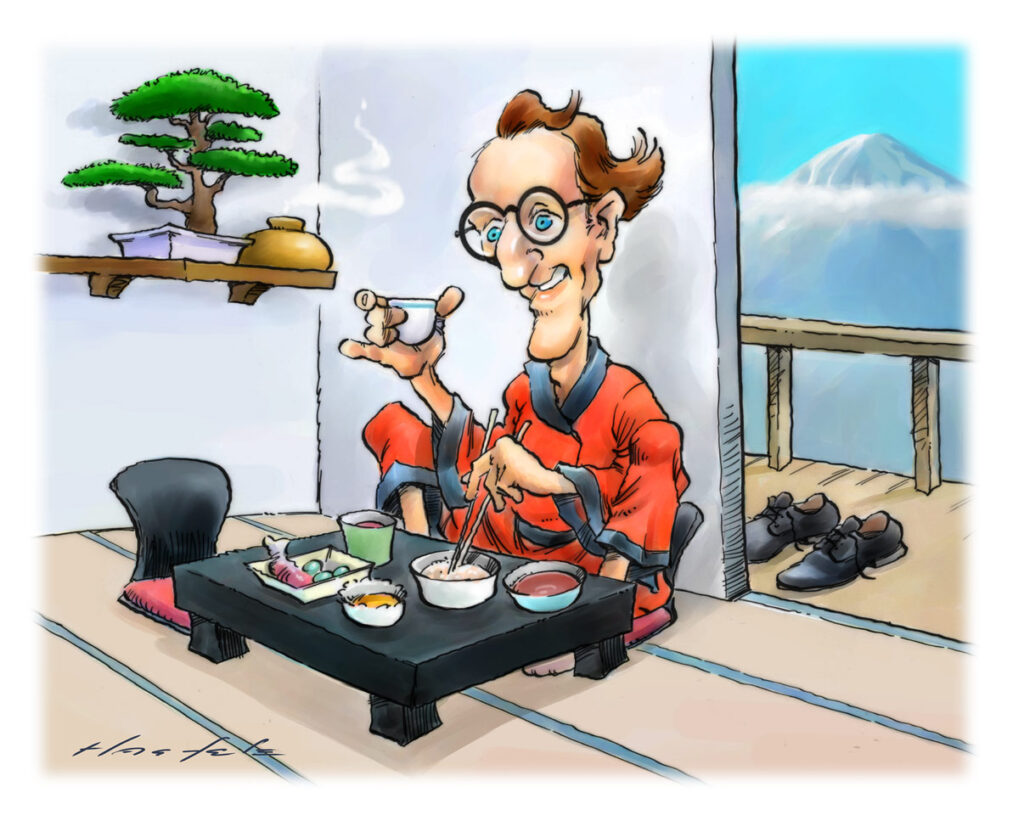
Japan beckons from across the vast Pacific. For many Americans, myself included, Japan is irresistible. In my case, it seemed to come to me. In the post-World War II era, Japan’s technological advancements greatly influenced America in many ways.
It’s an ancient dynamic. The culture of the conquered becomes, to a greater or lesser extent, the culture of the conqueror. It’s always a two-way exchange. Rome conquered Greece, but the culture Rome spread throughout the Western world was largely Greek.
In the postwar world, Japan’s technological prowess and innovation in manufacturing set the standards for the world. In the ‘50s U.S. companies were invested in vacuum tube technology, so they didn’t explore transistors. But Japanese companies did. They brought transistor radios to America. And they were not only a raging market success, transistors were the kind of innovation that would change the way people live. Transistor radios made it possible to take your radio to the beach, or anywhere else. And that was just the beginning.
Japan similarly shook up the auto industry. The American car manufacturers were taking car design to new levels, with wild baroque fins, extravagant clumps of chrome and vast swaths of sheet metal. Then the Japanese offered a different vision of car design, and Americans flocked to it. American car manufacturers had to retool their whole concept of what they were doing.
Sony invented the Walkman that lets you take your private soundtrack wherever you go. Toshiba produced the first mass-produced laptops. JVC gave us the VHS recorder. These products all brought new ways of living, and a design sensibility that was brilliant and irresistible.
We could talk about sushi and sake, and the rest of Japanese cuisine. It was radically different from what Americans were used to, but it has become one of America’s favorite cuisines. And there’s the haiku, those amazingly succinct, tightly structured little poems.
The list could be endless, but there is something that all these works of genius have in common, something at the core. That was what I was seeking in going to Japan. The common element that connects all these things, though un-nameable, is omnipresent in Japan. Whether or not you can define it, or understand it, you can experience it. You can be at the core from which that very special consciousness radiates.
And that is probably the most appropriate way to approach it, not to try too hard to understand. Just experience it. Focus on the present. Isn’t that how the Zen masters suggest you approach things?
Zen and Japanese Culture
Japan’s unique version of Buddhism, Zen, was a rage in the U.S. in the ‘50s. Jack Kerouac, king of the beats, waxed on it extensively, if not authoritatively. Its influence surged through American popular culture.
Buddhism came from India, evolved through China and then to Japan. Each country practiced it in accordance with its own culture. The way the Japanese modified Buddhism shines some light on the unique consciousness that has produced the marvels we have seen from Japan.
The word “Zen” comes from the Japanese zazen, “to sit and meditate.” Zen takes the “sit” out of meditate. In Zen, meditation can take place during action. The practice of Zen can lead to the kind of intense focus and poise that is reflected in many products of Japan.
In D.T. Suzuki’s introduction to Eugen Herrigel’s 1953 book, Zen in the Art of Archery, he wrote, “One of the most significant features we notice in the practice of archery, and in fact of all the arts as they are studied in Japan… is that they are not intended for utilitarian purposes alone or for purely aesthetic enjoyments, but are meant to train the mind; indeed, to bring it into contact with the ultimate reality.”
Through Zen, the archer eliminated the separation between himself and his target so much that hitting the bullseye became as easy as reaching out and touching it. Zen influenced all the arts and practices in Japan, and that includes technology and product design.
Among the most devoted practitioners of Zen were the samurai. If a swordsman loses his focus for a fraction of a second it could be the end of him. Zen was the perfect way to achieve that focus. As a samurai explained: “The thing of first importance for the swordsman’s personality… is to give up all desire for name and gain, all egotism and self-glorification. He is to be in accord with Heavenly Reason and observe the Law of Nature as it is reflected in every one of us.”
Behind all these things is the culture that embodies these qualities: the elegant design sense, the simplicity and economy, the concentration, the discipline, the love of nature. These qualities can be sensed all around when you are in Japan.
In the Magic Land
When I got to Japan, the effect was instant. I was suddenly plunged into the magical world from which those things I loved had emanated. Those things had come to me piecemeal. Now it was total, surrounding me. I was inside it. Every aspect of the world around me embodied this same consciousness, the same DNA I was drawn to in those innovations that had overflowed the boundaries of Japan and been welcomed into America with open arms.
My first stop was Tokyo. Even before finishing the airport arrival procedures, there was no doubt that I was in a whole new world. What struck me most was the Japanese sense of design. The architecture embodies this sense, from the gleaming skyscrapers to the tiny buildings with metal shingles on flying eve roofs, which in some instances stand right next to each other.
When you are immersed in Japanese design you can see the impact it had on Frank Lloyd Wright, which in turn had a powerful impact on American architecture. There is a consciousness that pervades everything you encounter in Japan. It’s a beautiful, alluring consciousness, via whatever medium it comes to you. There are many words that fit, but none that satisfactorily describe it.
That sensibility is well expressed in the design of the ryokans, the Japanese inns. It is a stark simplicity, but it’s a benign austerity because it is calming, comforting.
The ryokan I stayed in was a mind-altering experience. It was instant impact, to walk into your room for the night, and to see it furnished in a way that is radically different from how you usually live. It was a fundamentally different way of orienting yourself to the space.
The floors were covered with tatami mats, made of rice straw and woven rush grass. Outdoor shoes are left at the door. The floors are soft for walking or sitting, and those tend to be the ways you position yourself there. There was very little in the way of furnishings.
There was a square black table in the middle of the room that stood only a foot off the ground. And there were two chairs, without legs, more like stubby little feet. But they were lovely, carefully crafted pieces, heartbreakingly elegant. Everything was done on a level closer to the floor. The windows were translucent sheets on lattice frames constructed in rectangular patterns. When it was time to sleep you rolled out a soft, cozy mat.
There are endless things to share about Japan. So many memories: the hot springs and public baths, the gorgeously manicured gardens, the traditional clothing, the dance, Mount Fujiyama. Basically everything in life is new to you there. Everything is a little or a lot different.
I would have to put it among the few most essential places to experience at least once.
Your humble reporter,
A. Colin Treadwell


I agree with your assessments and memories; Japan is a unique and wonderful place. I have been there multiple times on business. I would love to take my wife there with Tauck, but the 13 hr flight seems beyond her tolerance.